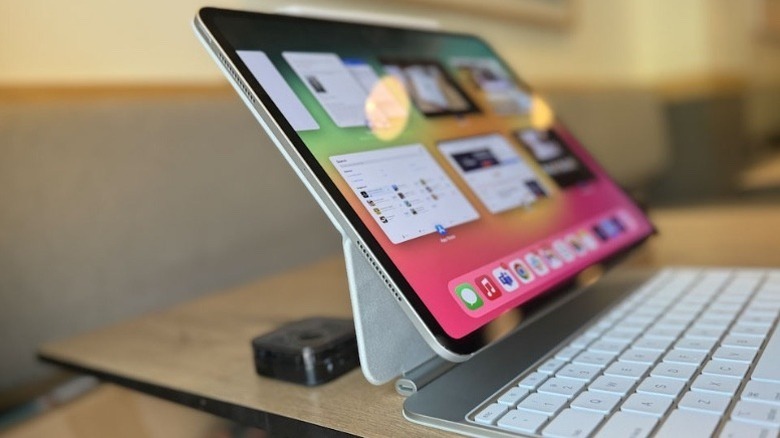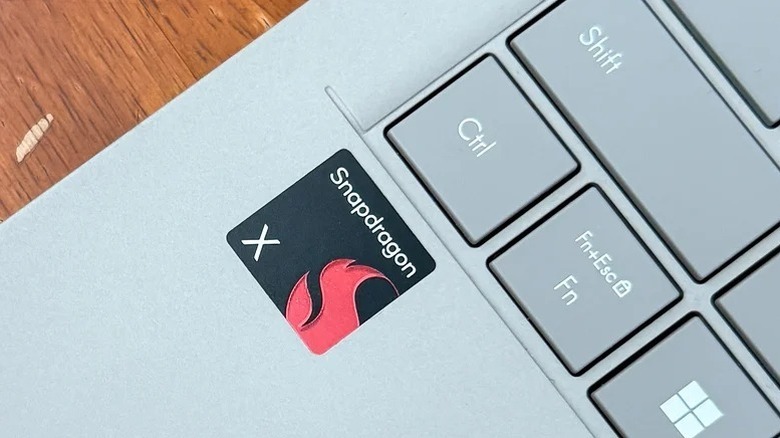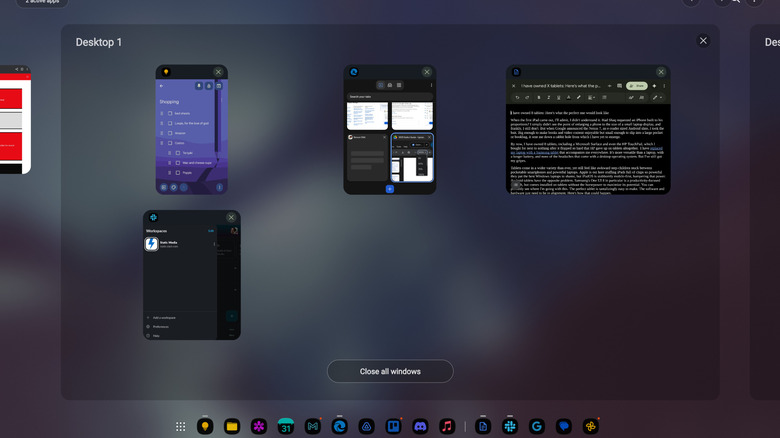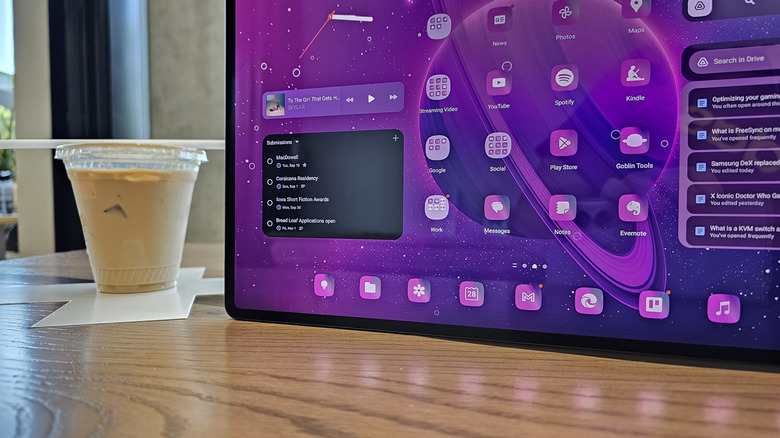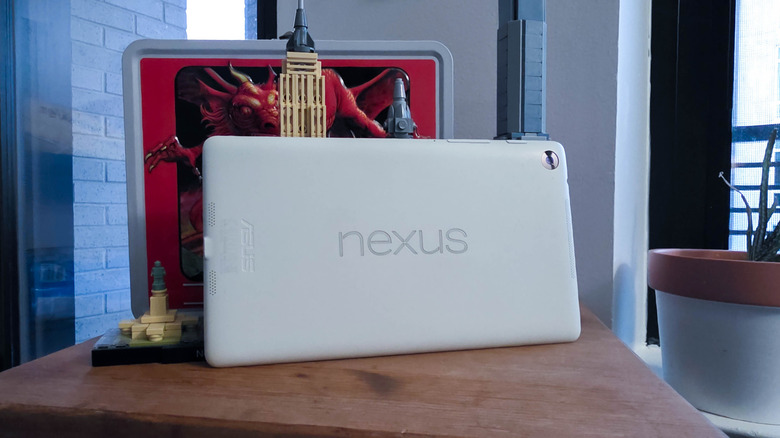I Have Owned 8 Tablets: Here's What The Perfect One Would Look Like
I'll admit that I didn't understand the first iPad when it came out. Had Shaq requested an iPhone built to his proportions? The point of enlarging a phone interface eluded me, and frankly, I still think the first-gen iPad was a mediocre product riding the iPhone's coattails. But I took the bait a few years later when Google announced the Nexus 7, an e-reader-sized Android slate. Big enough to make books and video content enjoyable but small enough to slip into a large pocket or bookbag, it sent me down a rabbit hole from which I have yet to emerge.
By now, I have owned 8 tablets, including a Microsoft Surface and even the HP TouchPad, which I bought for next to nothing after it flopped so hard that HP gave up on tablets altogether. I even replaced my laptop with a Samsung tablet that accompanies me everywhere. It's more versatile than a laptop, with a longer battery, and has none of the headaches that come with a desktop operating system. But I've still got my gripes.
Tablets come in a wider variety than ever, yet still feel like awkward step-children stuck between pocketable smartphones and powerful laptops. Apple is out here stuffing iPads full of chips so powerful they put the best Windows laptops to shame, but iPadOS is stubbornly mobile-first, hampering that power. Android tablets have the opposite problem: Samsung's One UI 8 in particular is a productivity-focused triumph, but comes installed on tablets without the horsepower to maximize its potential. You can probably see where I'm going with this. The perfect tablet is tantalizingly easy to make; the software and hardware just need to be aligned. Here's how that could happen.
Apple's iPad Pro is great, but its hardware outpaces its software
When a new iPad Pro comes out, it is shortly followed by a deluge of videos and articles asking whether it can replace a laptop. Every time, the answer is, "Sort of." Apple seems to have taken note, because iPadOS 26 makes the iPad more like a MacBook than ever before. But, to state the obvious, the problem is that it's still a touch-forward tablet, not a laptop. This misaligned purpose means that working on iPadOS feels like trying to use a Mac while suffering from a severe concussion. You can pull a window to you, but you can't push it to another screen? Come on, Apple. This is rudimentary stuff.
Where Apple excels these days is not software, but hardware. The M-series processors that power the majority of its computing products are genuine marvels of engineering. The latest M5 chip is putting the best Windows laptops to shame in single-thread benchmarks, and the iPad Pro's tandem OLED display is a cut above the competition, nestled in a thin chassis that looks every bit as premium as its price tag demands. In single-app use, I loved using an M4 iPad Pro, but I returned it after a couple of weeks because I found myself too frustrated by the convoluted workflow of iPadOS.
But after you've driven a Lamborghini, it's hard to love a Honda Civic. Back on my trusty Samsung tablet, I felt every ounce of the gap in performance. My mouse stuttered when editing big video projects, and I didn't have access to powerful apps like Final Cut Pro. But what if I could have the best of both worlds?
Could Qualcomm be the key to the perfect tablet?
In broad terms, my ideal tablet is essentially an M5 iPad Pro running Samsung One UI 8. Of course, sooner would Montagues and Capulets make peace than would Apple agree to such a device. But that doesn't mean all hope is lost. Qualcomm, the company that makes chips for Samsung and many other popular mobile brands, has been delivering laptop-grade chips in the Snapdragon X series. Those ARM chips currently power Windows Copilot Plus PC laptops. Although they aren't reaching the performance highs of Apple's silicon, they're a cut above the Snapdragon 8 Gen 5 processor powering the newest Android devices.
Technically, there's no reason Android couldn't run on Qualcomm's laptop processors. Market factors are the issue. Cheap Android tablets tend to sell better than high-end ones, and an Android tablet that could go toe-to-toe with the iPad Pro would be a huge investment. Even a company with Samsung's resources isn't going to sink time and money into making Android run on a more expensive processor. In fact, Samsung moved away from Qualcomm for the Tab S10 and S11 series altogether. Those devices use MediaTek Dimensity chips that don't quite measure up to the Snapdragon CPUs in, say, the Galaxy Z Fold 7. Power users like me buy those tablets regardless, so what incentive does the company really have to level them up?
At present, it is unlikely that Samsung or any other Android tablet manufacturer feels called to make a truly powerful tablet. Windows is there to fill that gap, even if app compatibility with ARM isn't all the way there yet. But there may be a glimmer of hope ahead.
The perfect tablet could be a Chromebook
The powerful Android tablet of my dreams might just be a Chromebook. This year, Google officially announced that it's folding ChromeOS into Android, a somewhat obvious move in hindsight. Google has had minor successes in the PC space, mostly by positioning ChromeOS as a way to fill schools with accessible laptops. Meanwhile, Android is the most popular OS in the world, beating Windows by a healthy margin. Is Google's next move a range of powerful, PC-like devices running Android? I sure hope so.
Android-powered Chromebooks might end up very close to my ideal tablet, especially if they come in hybrid form factors. But there are plenty of details we don't know yet. Will these Chrome-Android computers run in the new Desktop Mode for Android, which is currently available in DeX on Samsung One UI 8 and in the latest beta software for Pixel devices? I love the way Samsung deployed the desktop interface on tablets, and a lot of the changes point toward a device with more power than the lackluster MediaTek chips in the latest Galaxy Tab S11 lineup. For instance, there are now multiple workspaces you can swipe between, just like on Windows and macOS, and the mouse pointer now flows between screens when you connect a second display.
Maybe my desire for the perfect tablet has me seeing things that aren't there, but consider that Google worked directly with Samsung on One UI 8's DeX mode. The last time the two collaborated was when Google adopted Quick Share for the entire Android ecosystem, and before that, it was when Google revamped WearOS for all Android smart watches. At the very least, these desktop developments are worth keeping an eye on.
My dream tablet's specs
I've spilled a lot of digital ink explaining my perfect tablet in broad strokes: the best of Android software coupled with the best of Apple's hardware. But it might be useful to describe what that tablet would actually look like. Let's call it the mePad.
The mePad would have a large form factor, with a 14-inch display running a pixel-dense tandem OLED panel at 165Hz or higher. I could take or leave a folding display. It would be razor thin, like the Galaxy Tab S11 Ultra or iPad Pro, with a titanium frame (and user-facing screws for easy repair). Internally, a latest-generation Snapdragon X chip — or whichever processor is fastest at the time — would be accompanied by a vapor chamber cooling solution and at least 32 GB of RAM, which should be user-replaceable if the performance delta compared to soldered RAM isn't too large. Storage would also be replaceable, along with a microSD card slot. Borrowing an idea from gaming phones, it would have two USB-C ports, both with USB4 capabilities for 140-watt charging and high-speed data transfer. It would run One UI 8 with a few custom tweaks to solve my remaining gripes with Samsung's Android skin (a topic for another time, perhaps).
Accessory support is important, too. A charger would come in the box, along with an S Pen stylus (with Bluetooth support, unlike on Samsung's Tab S11 series). Will this tablet ever become a reality? Almost certainly not. It would be seen as too niche, and it would likely be priced prohibitively for most users. What's important to me, though, is that this combination of specs is not impossible to assemble. It could be built today.
The perfect tablet is a mirage
People have dreamt of the perfect tablet since long before the iPad, and a truly perfect one is unlikely ever to exist. Markets, corporate competition, and the pace of hardware and software innovation may never come into alignment to create that ideal gadget. Meanwhile, the AI race is greedily slurping up any capital that might otherwise have gone toward product R&D.
Not long ago, tech companies seemed eager to take big swings regardless of the risk. In that environment, an abundance of competition drove innovation, and Apple's competitors made a real effort to beat the iPad's early market lead. I don't think I'm waxing nostalgic for some hazy, half-remembered past. Things are more consolidated now, and product categories in the mobile space have calcified. The bleeding edge has moved on.
As I noted a while back while recounting the reasons Android tablets never beat the iPad, there's a lack of coherence between Google and hardware manufacturers. OEMs like Samsung have more share to capture in the lower end of the market, while Google isn't even sure what a tablet is or should be. Again, this isn't a technical puzzle; it's a question of priorities.
Pictured above is my 2nd-gen Nexus 7, pretty much the opposite of the "mePad" I dreamed up. What made it perfect wasn't the specs, but how it felt like a portal to endless possibilities. That's why I can't part with it, even though it barely runs anymore. The promise of better things is what makes tech special; maybe my perfect tablet is meant to remain a dream.

